Mathematical Modeling and Evaluation of Reliability Parameters Based on Survival Possibilities under Uncertain Environment
Alhanouf Alburaikan,Hamiden Abd El-Wahed Khalifa,2,Pavan Kumar,Seyedali Mirjalili and Ibrahim Mekawy
1Department of Mathematics,College of Science and Arts,Qassim University,Al-Badaya,51951,Saudi Arabia
2Department of Operations Research,Faculty of Graduate Studies for Statistical Research,Cairo University,Giza,12613,Egypt
3Division of Mathematics,School of Advanced Science and Languages,VIT Bhopal University,Sehore,466114,India
4Centre for Artificial Intelligence Research and Optimization,Torrens University Australia,Brisbane,4006,Australia
5Department of Mathematics,College of Science and Arts,Qassim University,Ar Rass,6688,Saudi Arabia
6YFL(Yonsei Frontier Lab),Yonsei University,Seoul,03722,Korea
ABSTRACT In this article,mathematical modeling for the evaluation of reliability is studied using two methods.One of the methods,is developed based on possibility theory.The performance of the reliability of the system is of prime concern.In view of this,the outcomes for the failure are required to evaluate with utmost care.In possibility theory,the reliability information data determined from decision-making experts are subjective.The same method is also related to the survival possibilities as against the survival probabilities.The other method is the one that is developed using the concept of approximation of closed interval including the piecewise quadratic fuzzy numbers.In this method,a decision-making expert is not sure of his/her estimates of the reliability parameters.Numerical experiments are performed to illustrate the efficiency of the suggested methods in this research.In the end,the paper is concluded with some future research directions to be explored for the proposed approach.
KEYWORDS Reliability function;probabilistic function;piecewise quadratic fuzzy numbers;survival possibility;failure rate;possibility distribution;state function;closed interval approximation
1 Introduction
In the past three decades,one of the challenging endeavors has been the design and manufacturing of large-scale reliable systems.These large-scale reliable systems are used in various application areas.Some of them are military applications,space exploration,commercial operations,and others deal in power distribution.Unlike the manufacturing of components,the manufacturing of such reliable systems includes the broader aspects of organizing composite manufacturing tools,operating organization and costs,as well as maintenance schedules,plus the skills required to make the system performance as an integrated entity too.
The study field of reliability engineering contains various activities,of which reliability modeling happens to be one area of the utmost significant.The traditional solution techniques are applied extensively based on probabilistic techniques,while the system survival probability is formulated by considering the statistical information (reliabilities or survival probabilities) of its sub-systems or components.In 1982,Martz et al.[1] studied the Bayesian reliability with a detailed analysis.The statistical information is obtained most of the time subjectively.They used a methodology to deal with the reliability in machine systems,with an application to error possibility.Gupta et al.[2]used the hybrid data to study the reliability parameters of a conveyor model.
A fuzzy set is adopted to cope with the uncertainty in mathematical models.In 1965,Zadeh[3] introduced fuzzy sets.Later in 1968,Zadeh [4] presented the concept of probability measures of fuzzy events.Over a short span,several researchers presented their works with reliability applications using fuzzy sets (Dubois et al.[5],Keller et al.[6],Onisawa [7],etc.).In the meantime,Onisawa[8] studied system reliability modeling with the application of fuzzy sets.Cai et al.[9] proposed the possibility concept to deal with uncertainty.They presented fuzzy variables to study the fuzzy reliability.Human reliability was studied with the help of fuzziness(Liang et al.[10],and Huang[11]).Some applications of fuzzy sets to reliability analysis were investigated by Bowles et al.[12],Murata[13],and Bing et al.[14].In 2002,a risk assessment approach was investigated for implementing the uncertainty using fuzzy set theory by Cho et al.[15].
In 2007,Hryniewicz[16]used the fuzzy triangular numbers to determine the reliability parameters.After that,Karimi et al.[17]presented a novel technique related to fuzzy probability.They studied the risk assessment model for natural hazards.Later,some authors extended the risk concept to a fuzzy risk matrix in various ways.The reliability assessment and situation assessment were studied by using the multi-criteria decision-making approaches by Lu et al.[18],and then extended by Ding et al.[19].Jain[20]studied the piecewise quadratic fuzzy number and presented the close interval approximation to fuzzy fractional programming problems.There are many papers related to the investigation of a mathematical model to handle the uncertainty to risk analysis.Later,Gargama et al.[21] extended fault and event tree analysis for failure mode effects using fuzzy logic.They presented an application to a fault and event tree analysis.In 2021,Varghese et al.[22] formulated a reliability model and evaluated using various fuzzy numbers,for instance,pendant,hexant,and fuzzy octant numbers.
Several researchers used the fuzzy interval to deal with uncertainty in reliability models(Washio et al.[23],Utkin et al.[24],etc.).The uncertainty in fault trees was studied for bridge construction by many researchers.Wu[25]presented a novel approach based on closed fuzzy numbers for reliability analysis.The fuzzy probability has an extended role in reliability analysis,which was presented by numerous authors (Yu et al.[26],Ung et al.[27],etc.).Purba et al.[28] studied the nuclear event reliability data to evaluate the reliability parameters.They considered the data related to failure possibility by using a new defuzzification method based on area.Arunraj et al.[29]proposed a novel approach based on the fuzzy set theory as well as Monte Carlo simulation.They presented the modeling under uncertainty and risk.In 2014,Purba et al.[30]presented a qualitative data processing approach.They used their approach for the assessment of fuzzy reliability.Maity et al.[31]developed a multi-objective transportation model considering the cost reliability in an uncertain environment.Recently,Yi et al.[32] introduced the triangular intuitionistic fuzzy number for reliability systems and decision making.They used the possible characteristics of fuzzy triangular numbers.Reliability evaluation and analysis have been studied by many authors in an uncertain environment.Examples are,but not limited to:Liu et al.[33],Li et al.[34],Xu et al.[35],Yang et al.[36],Jin et al.[37],and Zuo[38].
The above-reported literature review reveals the scope still remaining to innovate and study regarding both survival possibilities and the closed interval approximation of fuzzy numbers.Thus,a research gap is realized.In this paper,the reliability methods for modeling and evaluation based on survival possibilities and closed interval approximation of fuzzy numbers are introduced.
The outlay of the paper is constructed as follows: Section 2 introduces some of the notation and index needed in the problem formulation.In Section 3,reliability in possibility environment is discussed.Section 4 introduces the approximation of closed interval of piecewise quadratic fuzzy number for evaluation of the reliability with numerical example illustrates the efficiency of the method.Finally,some concluding remarks are reported in Section 5.
2 Preliminaries
In this section,some basics and concepts based on fuzzy numbers,piecewise quadratic fuzzy numbers,and their closed approximation intervals are recalled.
Definition 1.(Jain [20]).A piecewise quadratic fuzzy number (PQFN) is denoted by ˜aPQ=(a1,a2,a3,a4,a5),wherea1≤a2≤a3≤a4≤a5are real numbers and is characterized with the membership functionμ˜aPQis defined by(see Fig.1)
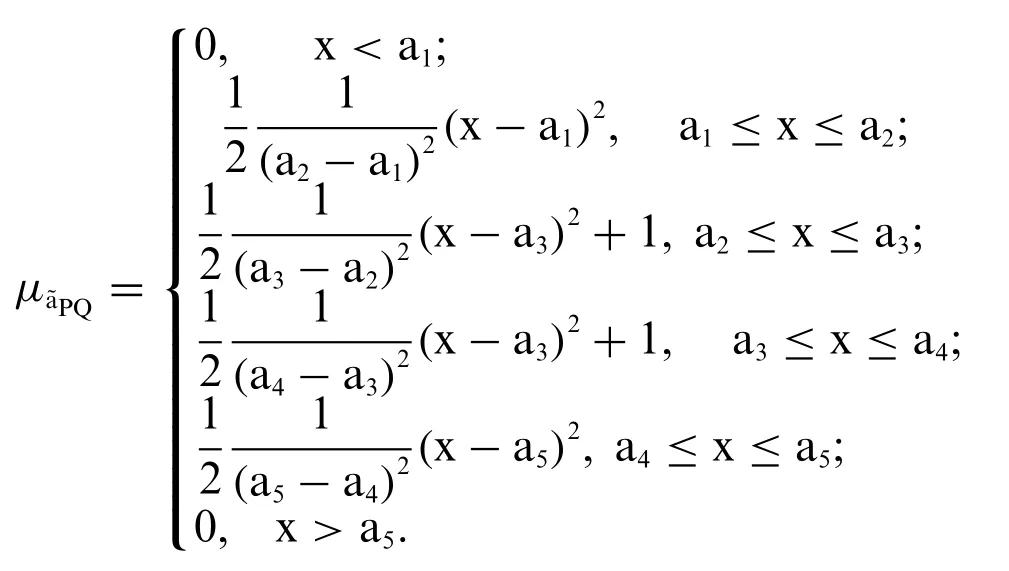
The interval of confidence at a levelαfor the PQFN is defined as

Definition 2.(Jain[20]).An interval approximation[A]=of a PQFNis referred as the approximation of a closed interval,when(aα)L=inf{x ∈R:≥0.5},and(aα)U=sup{x ∈R:≥0.5}.
Definition 3.(Jain[20]).The associated ordinary numbers of PQFN corresponding to the closed interval approximation
3 Possibility Theory of Reliability
Consider a fuzzy number ˜A with membership functiont)∈[0,1],t ∈[0,∞).This fuzzy number represents a fuzzy data on the breakdown of a component at timet.Therefore,we have Eq.(1):

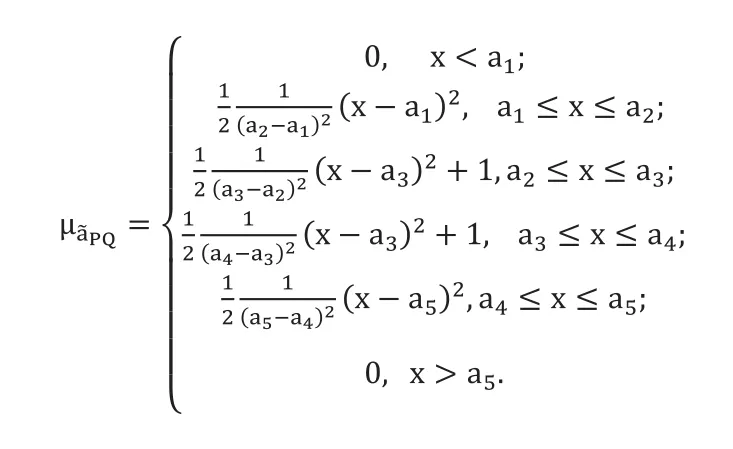

Figure 1:Graph of a PQFN
Also,consider the fuzzy number represents the possibility of failure at timet,t∈[0,∞).Thus,a law of possibilities of failure can be written as Eq.(2):

Remark 1:The possibility law of failure in(2)gives the possibility of failure occurring at timet.
Remark 2:is not necessarily a unimodal fuzzy number(i.e.,t)may have a flat at the top fort)=0).
Now,considerφas the time to failure,where we haveΨ(t=φ)=t=φ)=1.Sincet)is not necessarily a unimodal,φmay be over[φ1,φ2].
The cumulative failure possibility distribution ofΨ(t)over the interval[0,t]∈ℜ+is expressed by Eq.(3):

For t≥φ,we have Eq.(4)below:

Therefore,Λ(t)=Ψ(t)until t ≤φ,and after thatΛ(t)=1.In addition,we can define another representation law of possibility that the equipment will be surviving (i.e.,operating at the timet),namely the law of survival possibility which is denoted byΩ(t)and defined as the complement of the cumulative failure possibility distribution(Fig.2),by Eq.(5)below:

Assume thatΨ(0)=0,butΨ(0)may not be zero if the failure occurs immediately after the beginning of the service.In this caseΨ(t)andΛ(t)occur at the origin withΨ(0)=α <1 andΩ(t)will beΩ(0)=1-αwhich is lower than 1.Therefore,Ω(0)changes stepwise from 1 to(1-α)at the beginning of the service.
In the probability theory of reliability,the logarithmic derivative of the reliability functionω(t)is the failure rateψ(t)as expressed by Eq.(6)below:

Similarly,in the possible theory of reliability,we characterize the failure rate by Eq.(7)as follows:

The below demonstrated Table 1 gives the failure rate which is based on the possibility theory,Ψ(t),Λ(t)andΩ(t)

Table 1:Data of possibility of failure,Ψ(t),cumulative failure possibility distribution,Λ(t),and possibility Ω(t)in N
In the case oft∈N,the failure rate defined in Eq.(7)can be modified to rewrite by Eq.(8)below:

If the failure rateψ(t)is considered as basic data,the law of survival possibility (or reliability function)with the help of Eq.(7)is given as(Figs.3&4):
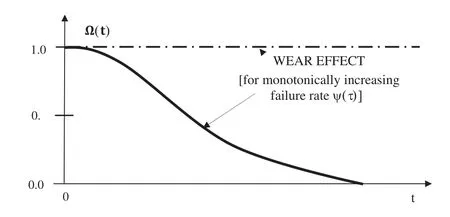
Figure 3:Survival possibility with monotonically increasing failure rate ψ(t)

Fort∈Nand by using Eq.(8)the reliability function is provided by Eq.(10)as follows:

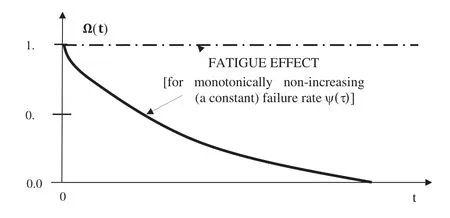
Figure 4:Survival possibility with monotonically non-increasing failure rate ψ(t)
Remark 3:
(i) The failure rateψ(t)is always non-negative.
(ii)ψ(t)is not necessarily monotone.
(iii) Once can get the initial failure rateψ(t)>0.
The solution of the differential Eq.(9) gives the Survival possibility in terms of the possibilistic failure rate by Eq.(11)as follows:

Fort∈N,the solution of differential Eq.(10)can be obtained recursively by Eq.(12)as follows:

Hereψ(t-1)=1,Ω(t)=0 giving the time to failure t=φ.
Now,we examine some examples of reliability function as follows:
1.ψ(t)=ψ0=a fixed value for the failure rate.
The corresponding survival function is written by Eq.(13)as follows:

2.ψ(t)=ψ0t=a ramp type failure rate,and

There is another indicator of reliability called cumulative failure rate K(t),which is defined Eqs.(15)and(16)as

It is noted in the Eq.(17)below:

Proceeding in the same way,we obtain Eq.(18)as follows:

Now,let us consider the case where a system is introduced into a new service att=a.The survival function is conditioned ont=a.Thus,we obtain Eq.(19):

Here,it is observed thatΩa(t)is the survival function of the equipment of the ageafrom the time it begins its service.Thus,Ωa(t)is conditional possibility conditioned on survival age fromt=0 to t=a,which is given by Eq.(20):

The corresponding failure rate is computed by Eq.(21)as follows:

In addition,the cumulative failure rate is given by Eq.(22)as below:

4 Approximation of a Closed Interval for Piece-Wise Quadratic Fuzzy Numbers for Reliability Evaluating
This section is divided into two sub-sections as follows.
4.1 Approximation of Closed Interval
Consider the situation where an expert is uncertain about the estimation of model parameters.Instead of describing the reliability function using one survival law,he/she gives two subjective functions forming an interval of confidence.For example,he/she gives
Ω°(t):The lower law of survival,
Ω°(t):The upper law of survival.
Through the closed interval approximation,the subjective survival law can be represented by Eq.(23)below:

Theorem 1.At a given timet

Proof
From the Definition of the failure rate and the survival function,we have
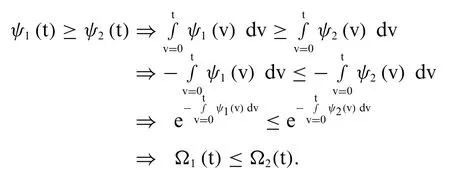
This completes the proof.
Theorem 2.Letψα(t)=[ψ°α(t),ψ°α(t)];∀t∈ℜ+be the closed interval approximation of piecewise quadratic fuzzy numbers of failure rate withΩ°α(t)≤Ω°α(t)andΩα(t)=[Ω°α(t),Ω°α(t)]be the corresponding closed interval approximation of possibility of survival.Then,we have the Eq.(25)as follows:

4.2 Reliability Evaluating
In this sub-section,we present some examples as follows:
Example 1.Let the closed interval approximation of the failure rate be given by
ψα(t)=[ψ°α(t)=γ1,ψ°α(t)=γ2],γ2≥γ1.
The corresponding closed interval approximation for the survival law is presented by Eq.(26)as follows:

The data of failure rate and survival law for the Example 1 is illustrated in Table 2 below:

Table 2:Failure rate,ψ(t)and survival law,Ω(t)(Example 1)(γ1=0.1,γ1=0.15)
Now,let the failure rate be
ψα(t)=[ψ°α(t)=tγ1,ψ°α(t)=tγ2].
Then,the corresponding survival law is presented by Eq.(27)as follows:

The failure rate is not necessary monotonic,but the cumulative failure rate is always monotonic as in the definition,therefore we obtain Eq.(28)below:

The closed interval approximation of the cumulative failure rate is expressed by Eq.(29)as under:

In addition,it is possible to define in another way the closed interval approximation for the survival lawΩ(t)using the inverse time functiont(Ω)instead of the survival function.In this case,the closed interval approximation for time to survival with reliabilityΩis as in Eq.(30)below:

Lemma 3.For allt,t1,t2∈R,we have Eqs.(31)–(32)as under:

Example 2.We have Eqs.(33)–(34)as follows:

The corresponding closed intervals approximation for time to survival for allΩ∈[0,1],are in Eqs.(35)–(36)below:

The divergence of these two cases is evaluated and are expressed in Eq.(37)as under:

It is quite evident that forξ(Ω)increases monotonically whenΩdecreases withξ(Ω→0).In the reliability theory,it is usual to consider the mean failure time.In the possibility theory of reliability,is defined by Eqs.(38)–(39)as below:

In terms of failure rate,(t),is defined by Eqs.(40)–(41)as follows:

By applying the survival law,one can writeas presented in Eq.(42)below:

Example 3.Consider an example using the failure rate and the survival law given in this Table 3:

Table 3:Data of failure rate,ψ(t)and survival law,Ω(t)(Example 1)(γ1=0.1,γ1=0.15)
Using Eq.(41),the mean failure rate is given by Eq.(43)as follows:

Also,the mean failure rate using Eq.(42)is given by Eq.(44)below:

Thus,the closed interval approximation for the mean failure time(referring to Table 2)is given by=[3.732,4.448].
Remark 4.It is trivial to observe thatis less than or equal toas presented by Eq.(45)below:

5 Conclusions and Future Research Directions
In industrial problems,the performance of the system reliability is of utmost concern.Thus,the outcomes for the failure of one or more machines are required to compute with extreme care.In this paper,we have demonstrated that when uncertainty is associated with the system,the reliability function,as well as some other similar criteria,are formulated as a mathematical model using the closed interval approximations of a piecewise quadratic fuzzy number.Apart from this,the intervals of confidence of fuzzy numbers,instead of the probabilistic,are also used in suggested modeling to handle the associated uncertainty.Extensions of the possibilistic criteria to several scenarios of reliability evaluation may lead to some interesting studies.There are several future possibilities to extend the proposed work in many application areas.One can consider the fuzzy type-2 sets (Tang et al.[39]),neutrosophic sets [40],and LR possibilistic variables [41] and deal with the uncertainty for further extensions of current research.
Acknowledgement: Researchers would like to thank the Deanship of Scientific Research,Qassim University for funding the publication of this project.
Funding Statement:The authors received no specific funding for this study.
Conflicts of Interest:The authors declare that they have no conflicts of interest to report regarding the present study.
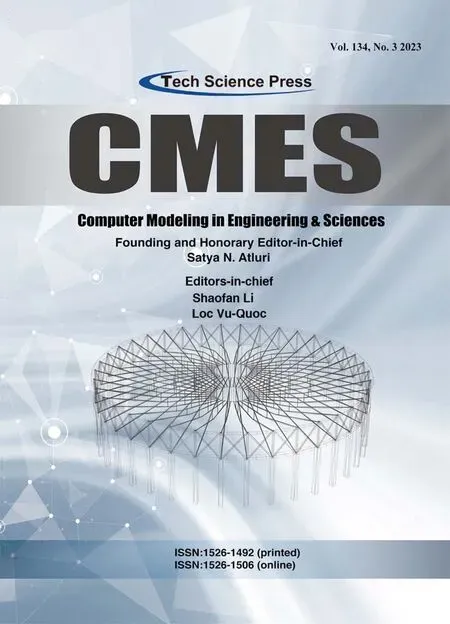 Computer Modeling In Engineering&Sciences2023年3期
Computer Modeling In Engineering&Sciences2023年3期
- Computer Modeling In Engineering&Sciences的其它文章
- A Consistent Time Level Implementation Preserving Second-Order Time Accuracy via a Framework of Unified Time Integrators in the Discrete Element Approach
- A Thorough Investigation on Image Forgery Detection
- Application of Automated Guided Vehicles in Smart Automated Warehouse Systems:A Survey
- Intelligent Identification over Power Big Data:Opportunities,Solutions,and Challenges
- Broad Learning System for Tackling Emerging Challenges in Face Recognition
- Overview of 3D Human Pose Estimation
